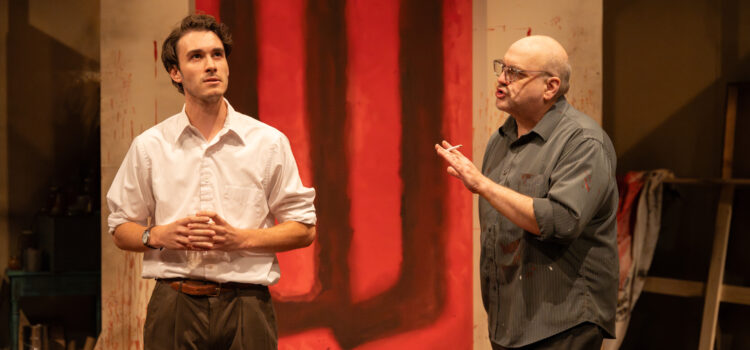By Lynn Venhaus
“What do you see?”
The opening line of “Red” establishes the essence of this brilliant fact-based drama by John Logan.
An invigorating portrait of abstract expressionist Mark Rothko focuses on the singular artist at a crossroads in his career. An astounding Christopher Harris has vividly sketched this mercurial icon with intense physicality and quicksilver verbal jousting.
Rothko, a Russian immigrant who arrived at Ellis Island in 1913 with his Jewish family when he was 10, was known for his uncompromising nature, ambition, obsessiveness, and troubled, restless mind.
In the 1950s, he rose to prominence in the ephemeral art world, and now is considered one of the most influential artists of the 20th century. But as his celebrity grew, so did his doubts about artistic integrity.
From 1949 to 1970, he rose to fame for his minimalist soft-edged, shaded rectangular color blocks on unframed canvases – such as “Lavender and Mulberry,” “Yellow Over Purple,” “Four Darks in Red” and “Orange and Tan,” which produced a variety of emotional responses.
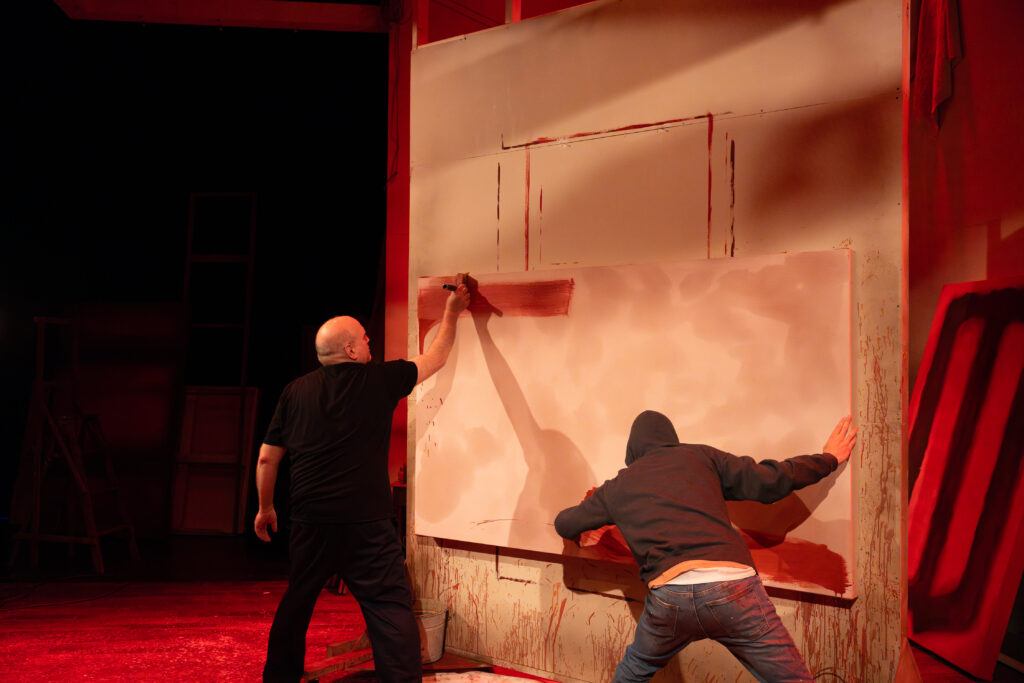
Through these infinite variations of vibrant divergent color blocks, he opened the power of raw emotions. Striving for depth, he employed layering in painting, and through his bold techniques for color, size and space, he crafted a signature style.
He was sensitive to harsh criticism that abstract art could be painted by 5-year-olds, as this fictional play indicates he was motivated by ideas and mindful of his legacy.
Harris’ Rothko alternates between reflection, frustration and pontification. Wanting to remain relevant and create a memorable work for posterity, yet irked by the monetary reason that went against his principles, he second-guessed a major decision.
He had accepted the largest commission in modern art history – $35,000, his first, from the deep-pocketed Seagrams to produce four large murals to hang in their building at the elite Four Seasons. The new place would become Manhattan’s poshest restaurant.
The time is 1958-59 and the place is a former gymnasium remodeled into an art studio in the Bowery neighborhood of New York City.
Through blunt conversations with his employee Ken (a fictional character that’s a composite of multiple assistants the iconoclast had), he will change his mind. But that defining moment comes after the men have intense and fascinating discussions about art, artists and the drive to create.
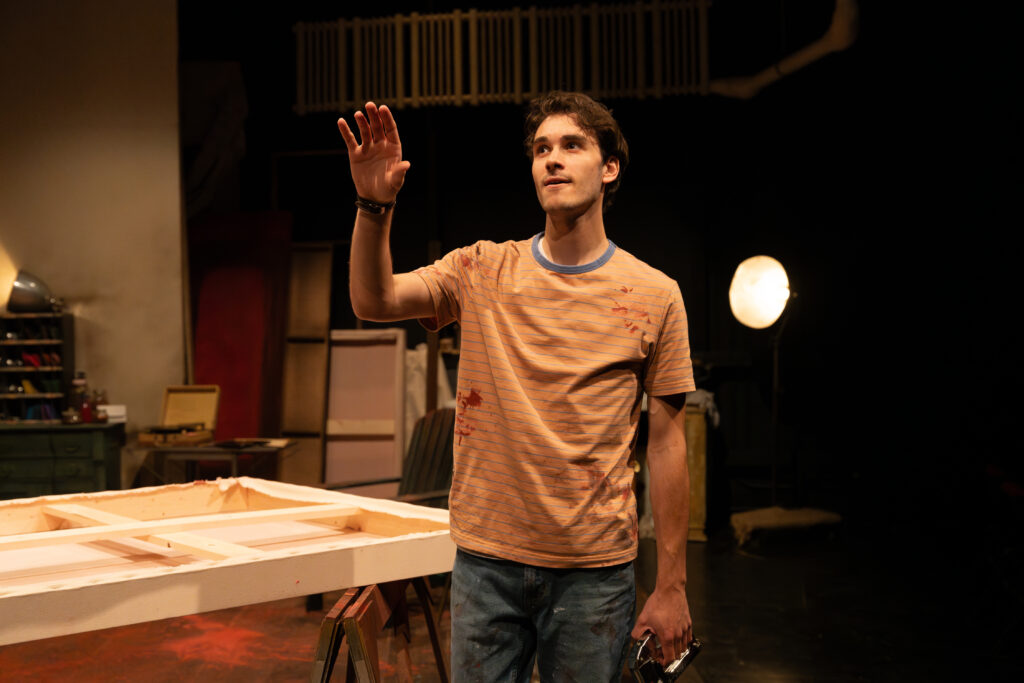
As the eager and earnest assistant, the intuitive young actor Dustin Lane Petrillo delivers another perfectly calibrated performance, following his dynamic turn as Hamlet in St. Louis Shakespeare’s production earlier this year, and was exemplary as the title role in “The Immigrant” at New Jewish Theatre last fall, nominated for a St. Louis Theater Circle Award.
Ken is an aspiring artist and is at first colorless, but we see his shadings emerge as he adapts to the complex and mysterious Rothko’s demands, outbursts and temperament. His rigorous assignments are to mix paint, build frames, stretch canvases – and get lunch, go on errands and whatever else his difficult boss orders.
Over a two-year period, gaining confidence, he begins to challenge Rothko, believing art should reflect change. Rothko’s vulnerability seeps through his façade, and so does his torment.
The tortured artist couldn’t quite reconcile the motives connecting commerce and art, especially rampant corporate capitalism. He wrestled with the role of art in society – décor or thought-provoking?
With this two-hander, the actors are strongest in collaboration – and they must create paintings live on stage, which is both daunting and enthralling. They accomplish it with elan.

They crafted a working relationship that alternated between tempestuous and harmonious, and the duo mesmerized for 90 minutes. You can feel them challenging each other, demonstrated by their mastery of the back-and-forth like they’re lobbing tennis shots in a Grand Slam final.
Harris. who has not only stage experience but also film, television and radio, was last seen in NJT’s “Life Sucks” in 2018. portraying Vanya in this comedic take on Chekhov’s play “Uncle Vanya.”
Taut direction by Alan Knoll makes this tightly controlled atmosphere engrossing. The comic relief is well-timed, and the material richly textured. Knoll had gracefully directed two triumphant Neil Simon comedies for NJT in recent years – “Brighton Beach Memoirs” and “Broadway Bound.” This show is a tall order, and he’s up to the demands, because to pull all of this together had to be an incredibly arduous task.
During this play, Rothko rails against the status quo, disparaging people who preferred safe pieces suited for “above the mantel,” revealing Rothko’s disdain for his contemporaries and the rising stars of pop art.
Battling depression his entire life, Rothko died by suicide in 1970. He was 66. The play does not include an epilogue, preferring to concentrate on that momentous two-year period of passionate creativity in the late 1950s.
He would go on to cancel the Seagram contract in 1960, and instead donated pieces to the Tate Gallery in London in 1966.
Well-researched and thoughtfully written by Logan, “Red” elevates art appreciation. He is meticulous in conveying Rothko’s strong scholarship in art history, bringing up the effect Rembrandt’s emotive use of light had on him when seeing one of the Dutch masters’ paintings, and other impactful pieces.
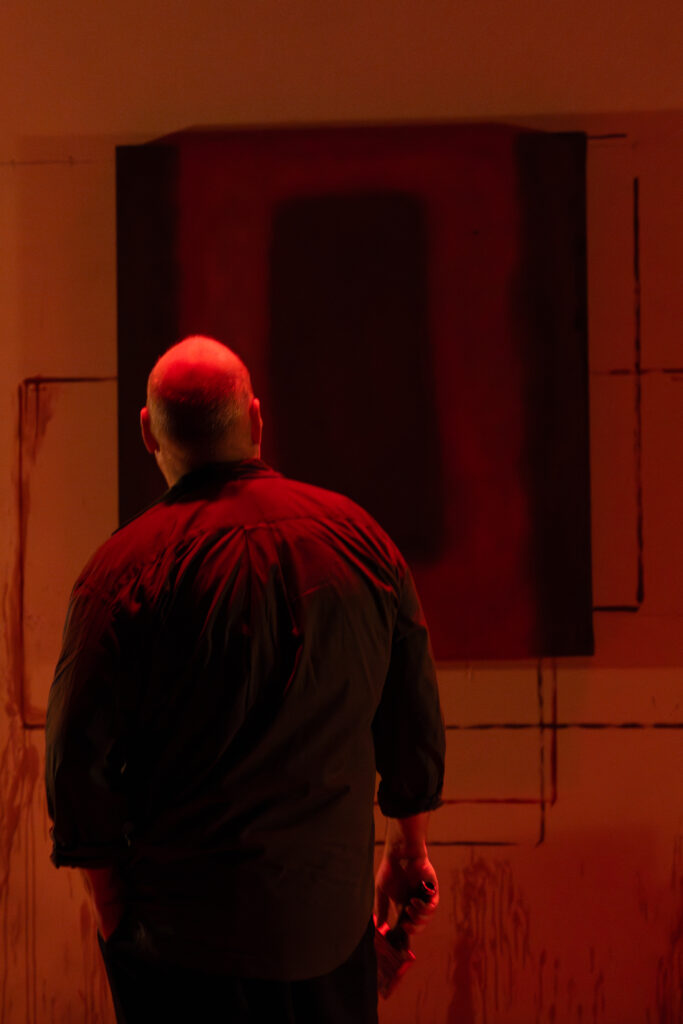
The visceral drama won the Tony Award for Best Play in 2010, taking home five other awards including one for Eddie Redmayne as Ken for Best Featured Actor in a Play. (Alfred Molina, who originated the leading role, lost to Denzel Washington for “Fences.”)
The St. Louis-based Fox Theatricals was among the Broadway producers. The Repertory Theatre of St. Louis presented the show in 2011, opening its 45th season soon after the play’s triumphs in London and NYC, and it hasn’t been professionally produced regionally since then.
Logan, whose lauded career includes writing plays for 10 years in Chicago before penning the screenplays “Any Given Sunday” in 1999, Ridley Scott’s “Gladiator” in 2000, Martin Scorsese’s “The Aviator” in 2004 and “Hugo” in 2011, the latter three all Oscar-nominated, and two James Bond films for Sam Mendes, “Skyfall” in 2012 and “Spectre” in 2015.
The New Jewish Theatre produced Logan’s chilling first play “Never the Sinner” about killers Leopold and Loeb in 2017.
Scenic designers Peter and Margery Spack, whose painstaking details often stun in breadth and scope in the Wool Studio, have transformed this pliable space into a functional work, with outstanding props collected by Katie Orr. They have replicated, with permission, Rothko-style canvases.
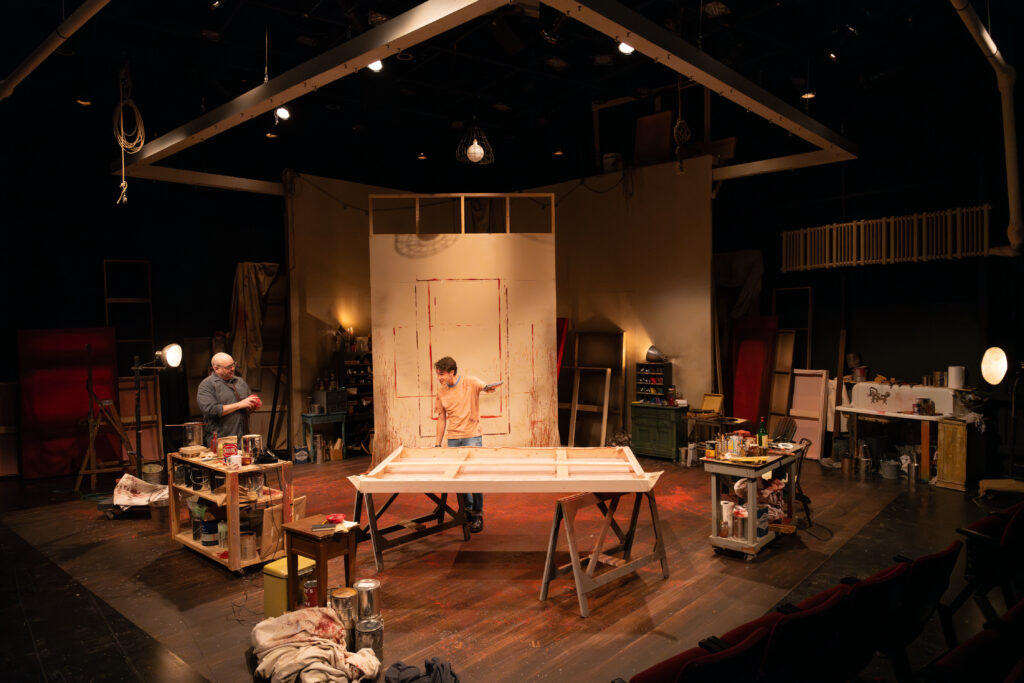
The award-winning designers studied archival photos and accounts to recreate the studio as faithfully as possible in the theater, including an Adirondack chair Rothko favored.
Lighting designer Jayson M. Lawshee has expertly shut out natural light, per Rothko’s notorious edict, while sound designer Justin Smith has astutely selected mood music of preferred classical and period jazz pieces. Michele Friedman Siler, whose period costume designs are notable for their accuracy, outfits the two artists appropriately.
Rothko once wrote: “The tragic experience of catharsis is the only source of any art. Art is an adventure into an unknown world, which can be explored only by those willing to take risks.”
This inspired production honors risk takers and spotlights universal truths while presenting an interesting debate about the role of art in society. Featuring two robust performances and exceptional production values, “Red” should not be missed in this stellar environment.
This is not a rehash of your college modern art history class, and hurray for that distinction. The effort that went into every aspect of this stimulating show is obvious – and admirable.
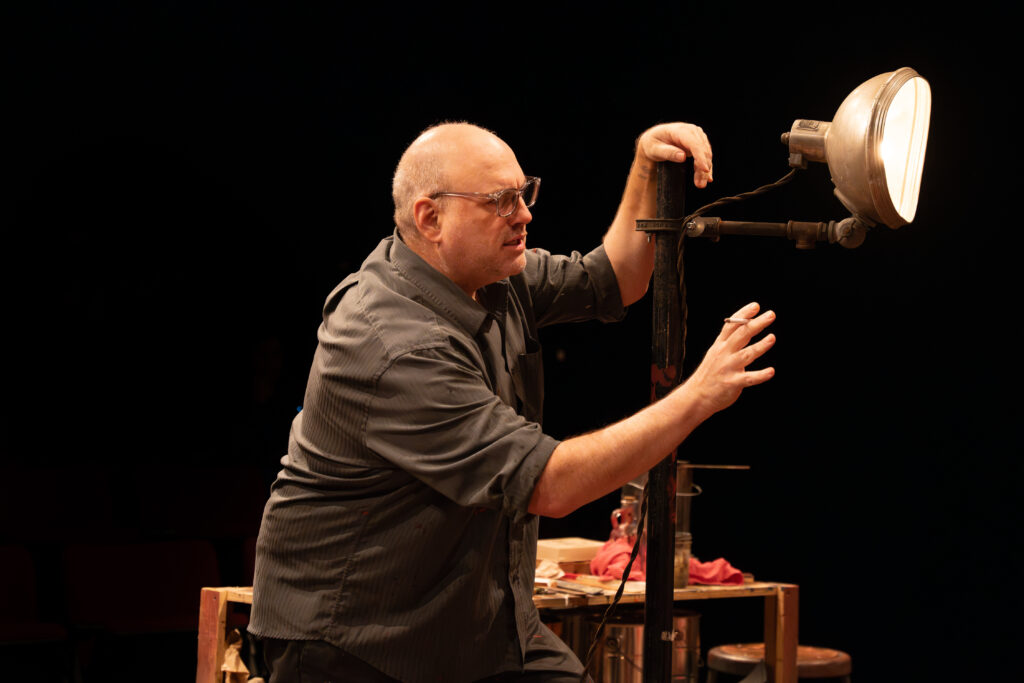
New Jewish Theatre presents “Red” July 25 through Aug. 11 in the SFC Performing Arts Centers’ Wool Studio Theatre, 2 Millstone Campus Drive, St. Louis. Performances are Thursdays at 7:30 pm, Saturdays at 4 and 8 pm, and Sundays at 2 pm. The show is 90 minutes without intermission. Tickets are available by phone at 314.442.3283 or online at newjewishtheatre.org. For more information: jccstl.com/arts-ideas/new-jewish-theatre/current-productions.
As a bonus event, scenic designer Margery Spack will give a presentation on her fascinating research into Rothko’s studio and the designers’ process in translating it for the NJT stage on Sunday, Aug. 4 following the 2 pm performance.

Lynn (Zipfel) Venhaus has had a continuous byline in St. Louis metro region publications since 1978. She writes features and news for Belleville News-Democrat and contributes to St. Louis magazine and other publications.
She is a Rotten Tomatoes-approved film critic, currently reviews films for Webster-Kirkwood Times and KTRS Radio, covers entertainment for PopLifeSTL.com and co-hosts podcast PopLifeSTL.com…Presents.
She is a member of Critics Choice Association, where she serves on the women’s and marketing committees; Alliance of Women Film Journalists; and on the board of the St. Louis Film Critics Association. She is a founding and board member of the St. Louis Theater Circle.
She is retired from teaching journalism/media as an adjunct college instructor.

